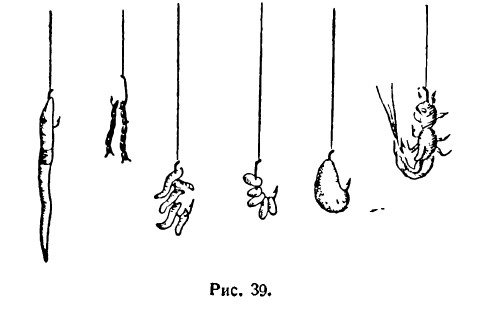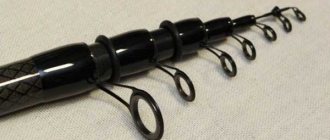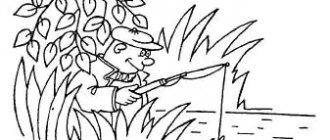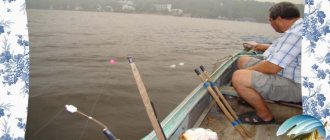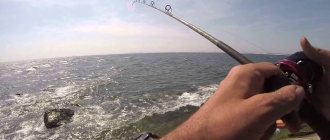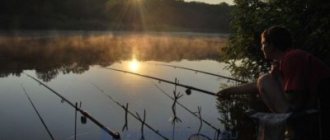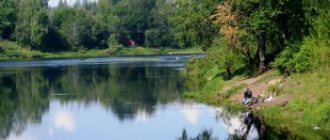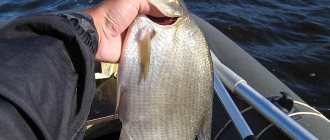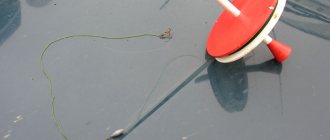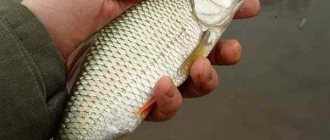Selecting and installing a fishing boat
Experienced fishermen most often use PVC boats for fishing with float rods. If the fish are very active, then any boat will do, but it is better to use an inflatable one. In currents, models with a length of 2.6 - 3 meters are best suited, maintaining good stability in the waves. A good option would be a boat with an inflatable chair of this type:
Since the fishing will be carried out with one float rod, we will use a minimum number of things: a fish tank, bait, baits, a small bag or box for spare equipment, a landing net and an anchor, and possibly a portable, wireless echo sounder. All this belongings will easily fit in a boat with the indicated dimensions. One person will be comfortable fishing in this case.
We will fish in the riverbed zone, so we pay special attention to the anchor. Often in such places at the bottom you can often find snags and trees carried by the current. It is best to find a more or less clean area and use a flag anchor of this type:
This design will avoid possible snags on the bottom. At the very least, their likelihood will be significantly reduced. To easily remove the anchor from the water, you need to tie a strong rope 20-25 meters long. It is better to attach a plastic bottle to one of the ends. When the anchor falls to the bottom, the boat will be carried away a little by the current, but then it will firmly stand in one place, since the anchor will rest against a small drop in the bottom. The bottle floats up, and you can use it to navigate where the anchor with the rope is.
If the current at the place where the boat is installed is significant, then use another weight. It is thrown in the opposite direction from the place where the first anchor fell. It is important that the distance from the boat to the two anchors is approximately the same, so that the boat is located in the middle.
Advantages and disadvantages of fishing from a boat
Let's look at the main characteristics of feeder fishing on the river from a boat, its advantages and disadvantages.
Advantages:
- Minimum time spent casting and retrieving gear. This is the first thing anglers notice on a boat. Indeed, most often you have to cast the feeder next to you, and you don’t have to make any long or extra-long casts. And this means reducing the time spent and increasing the efficiency of complementary feeding.
- Since you have to cast the feeder near you, and sometimes even literally “put it” several meters away, the accuracy of casting increases, and therefore the bait will be concentrated in one place.
- Due to more dynamic fishing from a boat than on the shore, you can test a larger number of combinations of baits, baits, flavors at the same time, try different equipment and leashes, and, if necessary, fish different promising places on the reservoir. All this makes fishing more effective in terms of collecting information and gaining experience.
- Free movement on a boat across a body of water allows you to better study it and even fish where it would be simply impossible to throw tackle from the shore. And if you have an echo sounder, you can create a detailed map of the bottom topography for yourself.
- You can cast the feeder in different directions from the boat, fishing a much larger area than from the shore.
- When catching fish, especially large ones, it is easier to land it and bring it to the landing net (vegetation, snags, etc. do not interfere, as is often the case on the shore).
Disadvantages can be divided into two groups:
- The main disadvantage is the inconvenience of being in the boat for a long time. At first, everything seems to be fine: you sit, swaying on the waves, everything is nearby, you cast nearby, you don’t look for a place on the shore and you have great freedom of movement. But a few hours pass and the lack of movement or the banal – lack of a toilet – begins to take its toll. It’s good if the boat is wooden, it is more stable than a rubber one. On a hard bottom, if there is no rocking, you can stand for a while and warm up. But still, it’s comfortable to stay on the boat for up to 8 hours maximum. After this time, I really want to go to the shore to stretch my legs, eat, and just walk around. You can’t take a lot of things on board with you; you’ll have to sacrifice some clothing or gear. And this is not always convenient, since you may often need something that was not needed for a long time, and you really don’t want to return to the shore from a baited point. Plus the lack of space and the associated inconveniences. For example, if the cord or fishing line overlaps at the tip, it will not be possible to put the feeder on stands on the shore, go to the cord and untangle it. Here we need to act differently. We place the feeder along the boat and move it back so that the reel does not dip into the water again, and the tip is within our reach. And there are a lot of such “little things”; for some fishermen, they become critical and do not allow the use of a feeder (with which, according to them, there is a lot of “fussing”) on the boat.
- In case of strong wind, current or its change, it is not so easy to keep the watercraft in one place. This makes it difficult to observe the tip, and the fishing process itself is not very pleasant, and often simply impossible.
Now, the general picture of such fishing is already emerging. Now let's talk about some things in more detail.
It is better to collect gear on the shore. If you have to change the feeder equipment, leash or feeder on the boat, there will be no problems, but if you need to replace the tip or assemble another feeder, you will have to spend extra time.
From the boat you can use the same feeder as on the shore. Many here will object and say that it is better to take a pickerel or even a side fishing rod with you. Let's not argue. If you have it, take it, but you can fish on the shore and on a boat with a feeder 3.6 meters or 3.9 meters long and not experience any feeling of “inferiority.” Moreover, a long rod is more helpful when landing fish, and large carp or bream love to see an anchor rope, rush to it and make several turns around. This is where a longer rod will help you better control the strong fish.
So, a boat feeder will fit with a standard “land” length, if there is a shorter one, then please, you can use it, it will even be easier with it in a cramped boat. It is important that the feeder has a flexible form. On a boat, it is better to use “soft” feeders; their flexibility will be less likely to allow the feeder to bounce in time with the boat rocking on the waves.
Since the fishing will be over short distances, you can use monofilament and a reel with a small spool diameter. The equipment of an onboard feeder is the most common: a paternoster or an asymmetrical loop; we choose the length of the leash depending on the current, the intensity of the bite and our beliefs (usually 50-100 cm).
The bait can be mixed on the shore or already in the boat, in any case, the main thing is to take everything with you so as not to return for some little thing.
When fishing with a feeder from the shore, one of the most important stages is studying the bottom and choosing a promising point for feeding. When fishing from a boat, the most important thing is to position the boat well so that it does not move from side to side and our feeding is effective. The main obstacles here are the current and the wind. Moreover, they can change noticeably throughout the day, which makes such fishing even more “interesting.” But the end result will justify our efforts after the boat is securely installed, especially since this is not very difficult to do.
When fishing with a feeder from a boat in the current, it is better to place the craft in a stretch with the current. We do this: we put the boat in a suitable place and throw a heavy bow anchor. We sail with the current (or wait until it simply drifts away) for 10-20 meters (depending on the depth of the reservoir), releasing the anchor line. We throw the stern anchor back a few meters, or paddle forward with the current, pulling the bow anchor rope. The rear anchor should be several meters from the boat. In this position, the boat will stand well with the current and “play” a little in a strong side wind. If you fish together in this position, you can create a trail of bait on the same line, thereby increasing the efficiency of feeding. The second option is to place the boat across the current, as shown in the figure.
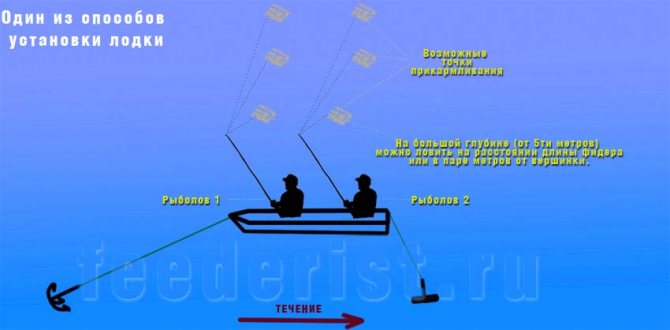
Promising places for line fishing
It is best to choose an area where the strength of the current decreases, and the depth at the fishing site was about 4-5 meters. This way you can securely fix the boat and you can count on catching silver bream, bream, roach and crucian carp.
A very promising place would be a sharp bend in the river. We find an area near the riverbed with the depth indicated above and cast the echo sounder. With its help, we determine promising depth differences, edges, and generally see if there are fish in a given place. Ideal if you can find the edge. We will do the wiring along its lower part. We will determine the length of the wiring experimentally, depending on at what points the fish will bite. The distance from the boat to the point where the float is cast should be 5-6 meters. Here it is enough to get into the same zone, and then let the equipment swim a certain distance.
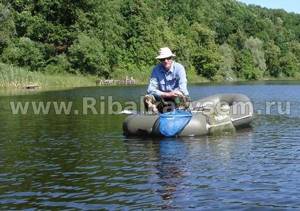
In general, finding good fishing spots from boats is not as difficult as it seems. On weekends, the riverbed zone in pressed-in reservoirs is occupied. On such days it is enough to outline a promising zone for yourself, and on weekdays, if possible, to fish.
Fishing from a boat in the current while drifting
Now a little about fishing from a boat on a drift current. This method is often used when fishing with a spinning rod or vertical line.
When a body of water is unfamiliar, drift fishing allows you to fish large areas and still find fish. The drift speed can be adjusted using a floating sail. This is a piece of dense fabric 1.2 x 1.2 m with a weight along the lower edge and a float along the entire edge along the top, made of foam plastic or a wooden strip, the buoyancy of which is enhanced by a tied plastic bottle. Adjustment ropes are sewn into the sides of the sail, running from the float down to the weight, which control the opening of the sail and thus regulate the drift speed.
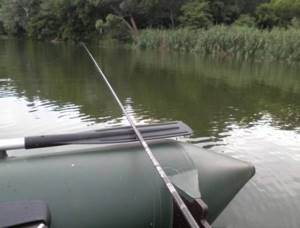
Drift fishing tactics are simple: you choose the optimal speed and try to walk along the ridges, if you are familiar with the terrain, fishing the surrounding area.
So, a short story in which you got acquainted with some of the features of fishing at anchor, learned a little about drift fishing, and also what donka is called on the Volga, has come to an end. All that remains is to wish you success in this exciting activity - fishing. We recommend reading the article about the Bolognese fishing rod.
Equipping a float rod for fishing from a boat in the wire
We will use a 4-meter Bolognese rod with a reel. It is better to install a small inertia-free spool with a spool size of 2000. With its help, it is easy to change the length of the line and land large fish.
We wind a fishing line with a cross section of 0.2-0.22 mm onto the spool. We will install a float with a drop-shaped body, stable in the current, with a carrying capacity of 3-4 grams.
The optimal length of the leash is 25-35 cm. We install the hook No. 10. Fish in such places usually take the bait quite boldly, so there is no need to use small hooks. We attach one sinker - a sliding type. In front of the loop for attaching the leash, we install a rubber stopper to limit the movement of the weight.
Feeding a place for fishing from a boat
The best option for feeding the zone would be to use a metal cage with bait balls. We lower it to the bottom just above the current. We always throw the tackle next to the fish tank so as not to catch it with the hook. The food will be washed away by the current, creating a path along the edge. The bait will swim along this path. If the current in the fishing area is minimal, then periodically we take out the fish tank and move it a little so that the food is washed out faster. We make the balls of medium density so that on the one hand they do not disintegrate very quickly, but on the other they collect a little dust, creating an attractive cloud of turbidity.
The starter feed consists of 7-8 balls the size of an orange. Next, as they are washed out, we place 1-2 balls in the net every 30-40 minutes.
If the current in the fishing area is stronger, then the bait is weighted with clay or soil. The balls are rolled more densely to achieve uniform washout of the mixture. The amount of bait depends on the duration of fishing. If we fish for 5-6 hours, then 5 kg of the mixture will be enough. Moreover, the simplest one will do. You can mix 1 kg of crackers, 1 kg of flour and 1 kg of store-bought bait and add 2 kg of boiled millet. You can use 100 g as a flavoring. coriander or several packs of vanillin. It is better to moisten the mixture with water from the river.
The best baits would be maggot, worm, mastyrka, pearl barley and bread.
The process of fishing from a boat
After casting the bait into the desired place, they begin the actual fishing. First, make 10-20 casts to establish the points where fish bites most often occur. After casting, the reel bail is left open so that the bait swims a certain distance. It is advisable to avoid sagging, so as not to lose control of the nozzle. The farther the float goes, the closer we tilt the nod of the rod to the water.
Usually bites occur near the boat and near the net with bait balls. As a rule, the first fish that are caught on the hook are roach, silver bream and bream. Moreover, at first you come across small things, but soon larger individuals catch up, and more and more often you come across quite pleasant roaches and bream weighing from 300 grams.
If the bites stop for a while, it means that bream or large crucian carp, and possibly ide, have arrived at the point. At this time, you don’t need to make noise, but just wait for bites. Sooner or later, the big fish will start to act. After hooking, the bream usually stands still and you have to use a little force to drag it a meter or two. Then the clutch will work, and the rod will absorb the jerks of the fish, and you can bring it to the boat.
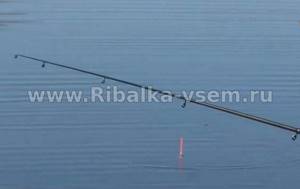
If you come across a large ide or chub, you will have to tinker a little. These fish can take the bait to a snag or other secluded place. After this, it is almost impossible to get them out of there. To keep the situation under control, you should tighten the clutch and forcefully keep the fish from trying to escape.
If there are no bites for a long time, then you can slightly hold the line with your finger. Pause for a few seconds and release the line again. Such manipulations are often followed by confident bites from roach and silver bream. During bites, it is advisable to make sharp but short hooks using a brush. If the hook is chosen correctly and it is sharp enough, then you can count on a high percentage of bites.
When using soft bread or semolina on the hook, the hooks should be made more smoothly. The tip of the hook will easily pass through the crumb and firmly stick into the lips of the fish.
If you manage to hook a large enough fish, it is slowly brought to the boat and taken on board with a landing net. No need to fuss about it. The main thing is to confidently perform all the actions in the correct order, and everything will be fine. It is advisable to use a landing net 3-4 meters long to catch fish a few meters from the side of the boat. This will be more convenient and safer.
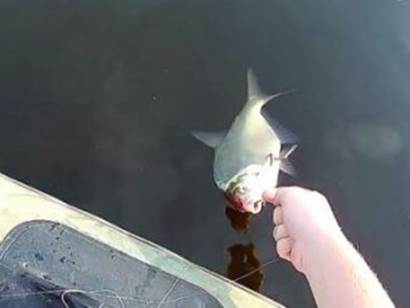
It is not recommended to stand up during all activities. This position of the angler can frighten off cautious fish that stay on the bait table.
The success of fishing depends on the depth at which the bait swims. It is very useful to change the fishing depth in the absence of confident bites. It is also useful to use leaders of varying lengths with foam attached to the hook. A very effective technique would be small nods with the rod, during which the nozzle makes chaotic vibrations.
When fishing in strong currents, you can cast the rig a little further upstream and use a heavier weight and float. This increases the fishing time and maintains a good chance of catching fish. In such places, the nozzle is usually lowered into the bottom layer. The probability of bites is higher here.
To successfully fish from a boat, it is important to choose one or more places. After each fishing trip, you should throw away all leftover bait. In this way, it will be possible to accustom the fish to the place. If we see that there is a lot of coarse grains in a given place, then we add more coarse grains to the mixture - steamed barley grains, wheat, peas and canned corn.
Fishing in the wire video
Selection and arrangement of seats
During the spring flood, almost all the fish leave the deep winter moorings, go to shallower, warmer places and stay there until autumn.
Ide, chub, and roach especially love the mouths of small rivers and streams, ravines and hollows through which streams of rainwater flow into the rivers. Saddles 2.5-3.5 m deep between two reaches also serve as a place for fish to stay; necks with a clay or gristly bottom and a stronger current; places directly adjacent to rifts; exits from deep places, especially where the riverbed approaches a steep, steep bank... Everything that can constitute food for fish swims here.
The best places for live fishing are channels below locks and mill dams, channels between reed thickets up to 2 meters deep, and in mountain rivers - places with a calmer flow between the riffles. Especially a lot of varied and large fish are found where the main stream approaches places abounding in mayfly larvae (“grandmothers”). Mayfly is found in clayey shores and is the most delicious food of all fish species. (See Fig. 41). Fishing is also good near the pile abutments of bridges, below the lull, where the right and left streams of water flowing around the abutments converge again and form a smooth, calm current.
Having identified a place for fishing, an amateur fisherman must thoroughly examine the bottom of the reservoir, its topography, depth, strength of current, select a flat area with an average depth and drive one or two stakes here for mooring the boat.
On mountain rivers with strong currents and a rocky bottom, a place for fishing and a boat mooring is arranged as follows: the most spread-out, double-topped fir or spruce, up to 3 meters high, is cut down; a heavy stone - an anchor - is tied to the partially chopped off top of the tree, and a “float” from a stump of dry wood is tied to the thickest branch of the butt part. Then the tree is transported in a boat to the chosen place for fishing and dumped into the water. The load drags the top of the tree down to the bottom, and the butt part rises and forms a barrier in the water. Only the “float” floats to the surface of the water. The fisherman ties the boat to one of the thick branches of the tree. Below it, a slow flow forms. In a mountain river, this alone is often enough to attract fish. And when you arrange additional feeding - “bait” for the fish, you can fully count on a good catch.
On lowland rivers, when constructing a berth for a boat, they usually use one stake. Its lower, pointed end is sometimes covered with sheet iron, and a small tube or ring is put on the upper end so that when the stake is driven in with a heavy wooden mallet, the upper end of the pole does not split. When the fisherman ties the boat to a stake behind the middle bench and sits on it himself, the boat takes a position across the current and is held quite steadily.
Now it is necessary to set up a “bait” for the fish, that is, lower the pre-prepared bait under the water near the driven stake.
Complementary foods are prepared from bran, steamed hemp or sunflower cake, from steamed bread grains (oats, wheat, rye, corn) or from flour. It is lowered under water in a mesh bag or using some other device two to three meters from the pin. The following animal baits are successfully used: ant eggs, bloodworms or chopped red worms mixed with soil.
For live fishing, two places are usually chosen where the bait begins to fall in the spring. The bait should not fall asleep in the evening, as some inexperienced fishermen do, but, if possible, during the hours when the angler plans to go fishing. If an angler fishes early in the morning, he should also add bait

early in the morning or about two hours, an hour before fishing. In this way, the fish are taught to visit the designated place at the scheduled hours for fishing.
Article on the topic: Fishing for carp in early spring
In no case is it recommended to add leftover complementary food or the complementary food itself before finishing fishing.
Figure 36 shows two types of bait: k - cabbage made from dough mixed with bran or steamed cake, into which an iron ring is smeared; m - bait in a mesh bag.
In places with a calm and even current, the bait can be lowered to the bottom without tying it to a stake. In these cases, bran, cake or steamed grains are pre-mixed with clay.
When the fisherman does not have grain food, it is useful to fill in three or four buckets of fresh road clay soil as
On the Kama River and in the lower reaches of the Vyatka, special bridges are widely used for fishing “with a wire” from the shore*
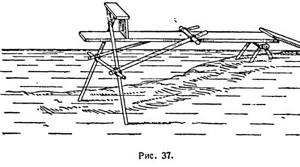
ki-goat. The structure of such walkways is shown in Fig. 37. When the water level changes, they move.
Sometimes, when fishing from the shore in a river with a strong current, hidden “drives” are made in the water within the distance of casting a hook with a nozzle. To do this, in a chosen place, at a right or slightly smaller angle to the shore, at a depth of 1 to 1.5 meters, four stakes are driven in. Then a lattice shield with a height of 1 to 1.5 meters and a width equal to the distance from the first to the last stake is woven from fascine or wicker. This shield is immersed above the stakes and pressed against them with the Baking. And so that the waves from passing steam codes do not move it from its place, the shield is tied to stakes. Such barriers - “drives” - attract a lot of fish such as dace, roach, silver bream, roach, podust and chub. If a “stop” is set up near the main riverbed or a deep reach, then over time larger fish will stick to it.
The process of fishing "in the wiring".
But now all the preparations for fishing have been made: the rod has been assembled and equipped, a place has been chosen, backfilling of bait has begun...
The fisherman prepares a bait for baiting a hook, takes with him a landing net, a cage or a basket for the caught fish, at the appointed time he carefully approaches the desired place and ties the boat to a stake. Using a depth gauge, he once again checks the “release” and finally sets the length of the line: the distance from the top of the rod to the float should not be more than one and a half length of the rod. The fisherman starts fishing.
He puts a “granny” larva or three or four “maggots” on the hook, lowers them into the water near the boat and takes the rod in his right hand. The weight carries the nozzle down, it quickly reaches the bottom, and the float takes a vertical position on the surface of the water and immediately sets off on its first swim, downstream. The rod should be kept raised so that the line is always in a tense position, but does not delay the free floating of the float.
The float reached the place where the bait is located at the bottom of the river. At this moment you need to watch him especially closely... But the first swim has not yielded anything yet. When the float moves away from the boat for the entire length of the measured line and rod, a smooth hook is made with your hand, and the float is pulled towards the boat. The rod goes all the way back. Then the float is picked up by the left hand and passed to the right, the rod again rises up and back to full capacity, and the left hand picks up the leader and leash with the hook and nozzle and again lowers them into the water near the side of the boat. The nozzle goes into the depths, the float, having taken a standing position, sets off again.
So he again approached the place where the complementary food is located and suddenly, lingering for one moment on the surface, disappears under the water. The fisherman makes a smooth swing of the rod back, and it... bends into an arc: a large fish entered on the fishing line in the depths of the river, offering strong resistance. It is necessary to take into account the possibility of the line breaking, so it is necessary to timely parry the unexpected throws of the Underwater “enemy”. Having reeled almost the entire supply of line from the reel, the fish finally stops, and Ryblov begins, meter by meter, overcoming stubborn resistance, to take the line back onto the reel. The fish was already very close. The fisherman slowly but steadily pulls it towards the boat itself. He can already see the “prey”: a handsome red-finned chub appears on the surface of the water. But at the moment when the angler takes the rod in his left hand in order to take the landing net with his right hand, the chub rushes headlong into the depths, trying to hide under the boat. An exciting, critical moment! Every effort must be made not to let the fish go under the boat and not to let him wrap the line around the stake.
Article on the topic: Carp behavior
The fishing tackle tested before fishing turned out to be in good condition. The chub, having exhausted all its strength, lies down on its side. The fisherman pulls him to the boat, places a landing net under him and, with some difficulty, lifts his catch into the boat...
A dry, dispassionate description of the fishing process says nothing about the experiences of the fisherman himself. The picture of this description will not be complete if nothing is said about these experiences. The fisherman’s feelings are especially acute at the last moment of his preparations, when the fisherman is already near the boat at the stake, and the fish approaching the bait with its powerful splashes lets him know that a large fish is approaching the bait. At this moment, the fisherman’s nerve tension reaches its limit.
To an outsider - not a fisherman, it sometimes seems that the fisherman is an impassive creature, that he is completely absorbed in the process of fishing and does not experience any special experiences and does not even notice the beautiful nature surrounding him. This is not true. The overwhelming majority of real fishermen engage in fishing, the main activity, because it is carried out in an environment and against the backdrop of wonderful, enchanting pictures of nature, far from noisy cities and in an environment conducive to the rapid restoration and strengthening of one’s physical strength.
The main thing on which the success of live fishing depends is the correct choice of place.
When choosing a location, it is necessary to thoroughly study not only the fishing area itself, but also the entire area of the river where the equipment for fishing is supposed to be carried out. In no case should you choose areas where seine or net fishing is carried out by commercial fishermen. It is also impossible to arrange sizh where the bottom of a flowing reservoir or river is uneven or where it gradually decreases; in these cases, it is impossible to set the correct “release” of the line, and the bait at the end of the swim rises too high from the bottom. If it is difficult to find a flat area for fishing, it is better to stop at the exits from deep reaches and holes, where the river bottom gradually begins to rise again.
You cannot fish in the same places all year round. Fish, depending on the season and even on the weather and time of day, changes feeding and stopping places. So, during summer floods, fish migrate for some time to the mouths of small rivers and even ravines, along which streams of rainwater rush into the river. In summer, during the hottest time of the day, fish tend to stay in the channels between the reeds, at the edge of the reeds, or under coastal trees hanging over the water.
Changes in the water level in a reservoir have a great influence on large fish. When the water rises after rains or for some other reason, the fish rush to river floods, to shallower places, and vice versa, when the water level drops, the fish go to deeper places. Only when a normal water regime is established in a flowing body of water does the fish return to its constant favorite places for a given season.
When fishing “in the wire”, the correct choice of nozzle is also important. It happens that two or three days ago you caught fish perfectly with grains of steamed wheat or oats, but today the fish does not touch this bait at all, and your neighbor, who fishes not far from you, gets bite after bite. It turns out that today the fish prefer a bait made from a small bunch of thread
Article on the topic: Boilies or Pop-ups? What to use?
What does the success of live fishing depend on?
Green algae for all other baits. Your neighbor figured out this “whim” of the fish before you. Rice. 39.
During the mass emergence of mayflies, it is pointless to catch even such a favorite fish bait as maggot or “granny”. In this case, you need to quickly rearrange your gear, pick up mayflies swimming past the boat and fish on top of this bait.
The following phenomena have also been noticed: for several days after the bait is filled in, the fish are caught perfectly, the fisherman takes home record catches. Then the catches become smaller and smaller every day, and finally, one “fine” day, the fisherman comes home with an empty basket. The fact is that you cannot endlessly fish in one place, especially every day. You need to give the fish and the place a “break.” 'It is recommended to arrange two sits with the fish attached to them and alternate fishing to give new schools of fish the opportunity to settle in the fished places.
The correct selection and preparation of bait for attracting fish also plays an important role. If you fish all summer with bait made from nothing but steamed grains, and your neighbor flavors the same bait with some odorous substance that attracts fish, or from time to time adds steamed hemp cake to the bait, naturally, your neighbor’s catches will be richer. The fish will prefer to feed where more tasty food is prepared for it.
An important factor influencing the success of live fishing is weather changes, especially in summer. So, when inclement, cold weather approaches, all fish, with the exception of burbot, stop being caught on fishing rods. In persistent hot weather in the middle and end of summer, the fish becomes inactive and lethargic, moves to deeper places, under steep banks and to holes with spring water outlets and settles there. You can take it at this time only with a medium and small-sized spoon baited with bloodworms and a jig.
In autumn, when the water in reservoirs is already sufficiently cooled and the fish sense the imminent approach of winter, weather changes affect it less. At this time, trying to stock up on fat for the winter, it often does not stop biting even in cold weather, but you need to look for it in deeper places.
Fishing stops completely when a cold northeast or north wind blows.
Fishing results are greatly affected by faulty fishing gear. Before (every serious fishing) it must be carefully checked at home. Hooks must always be perfectly sharp, tenacious and correctly selected in size in accordance with the prepared bait. You must not hook the cockchafer or
mend on a small hook or put a bloodworm or maggot on a heavy large hook.
It is also not recommended to hide the hook tip in it when baiting the bait. When biting, the fish does not feel the bait, but sucks it in along with the water, not paying attention to the sting of the hook. In those cases when the hook tip is hidden inside the bait, especially when using hard, dense baits, there are many so-called empty bites: when hooking, the hook does not catch the fish, but is pulled out of its mouth along with the hard bait.
Loud conversation, unusual noise or knocking on the bottom or side of the boat will certainly also affect fishing. Even the shadow of the angler and his rod scares away the fish, and this circumstance must be taken into account when choosing a place for daytime fishing.
